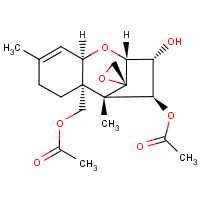Diacetoxyscirpenol
Agent Name
Diacetoxyscirpenol
CAS Number
2270-40-8
Formula
C19-H26-O7
Major Category
Biological Agents

Synonyms
3-alpha-Hydroxy-4-beta,15-diacetoxy-12,13-epoxytrichothec-9-ene; 4,15-Di-O-acetylscirpenol; 4,15-Diacetoxyscirp-9-en-3-ol; 4,15-Diacetoxyscirpen-3-ol; 4,15-Diacetoxyscirpenol; 4beta,15-Diacetoxy-3alpha-hydroxy-12,13-epoxytrichothec-9-ene; ANG 66; Anguidin; Anguidine; DAS; Diazetoxyskirpenol [German]; MM 4462; Scirp-9-ene-3alpha,4beta,15-triol, 4,15-diacetate; Scirpenetriol 4,15-diacetate; Trichothec-9-ene, 12,13-epoxy-4beta,15-diazetoxy-3alpha-hydroxy-; Trichothec-9-ene-3,4,15-triol, 12,13-epoxy-, 4,15-diacetate; [ChemIDplus] UN3462
Category
Mycotoxins
Description
Solid; [HSDB]
Sources/Uses
A mycotoxin of the group 12,13-epoxytrichothecene; [ChemIDplus] Reportedly used as biological/chemical warfare agent; [HSDB]
Comments
Trichothecene mycotoxins causes bone marrow suppression, leukopenia, and immunosuppression with susceptibility to sepsis; [HSDB] Of the naturally occurring trichothecenes, T-2 and diacetoxyscirpenol are the most potent; [Reference #1] Irritating to skin and eyes; Very toxic by inhalation, skin contact, or ingestion; Targets thymus, bone marrow, spleen, blood, and nerves; Effects in high-dose animal studies include allergic dermatitis and cyanosis; Causes GI bleeding after ingestion; [Aldrich MSDS] See "Deoxynivalenol." See "T-2 toxin."
Reference Link #1
Biomedical References
Exposure Assessment
Lethal Concentration
LC50 (mice) = 11.3 mg/kg
Explanatory Notes
The Guide in the Emergency Response Guidebook is for "Toxins, extracted from living sources, solid, n.o.s."
Adverse Effects
Toxic Pneumonitis
Yes
Dermatotoxin
Skin burns
Diseases, Processes, and Activities Linked to This Agent
Other Information
No other related information on this agent was found.